Analysis of Management Theories, Leadership, and Change Report
VerifiedAdded on 2021/04/17
|11
|3081
|94
Report
AI Summary
This report provides a comprehensive analysis of various management theories and leadership styles, including Maslow's hierarchy of needs and Herzberg's two-factor theory, and their practical applications within organizations like Fonterra and Fisher & Paykel Healthcare. It explores different leadership approaches such as Laissez-Faire and Charismatic leadership, exemplified by Steve Jobs and Jeff Bezos, and examines the delegation process and its effective implementation. The report also delves into change management, using Lewin's three-step model and the 'White Waters' metaphor, and discusses external forces driving innovation. Strategic planning, operational planning, and SWOT analysis are applied to The Simunovich Olive Estate, highlighting the importance of menu planning and adapting to market competition. The report offers strategies for change agents and emphasizes the role of communication and leadership in successful organizational change.
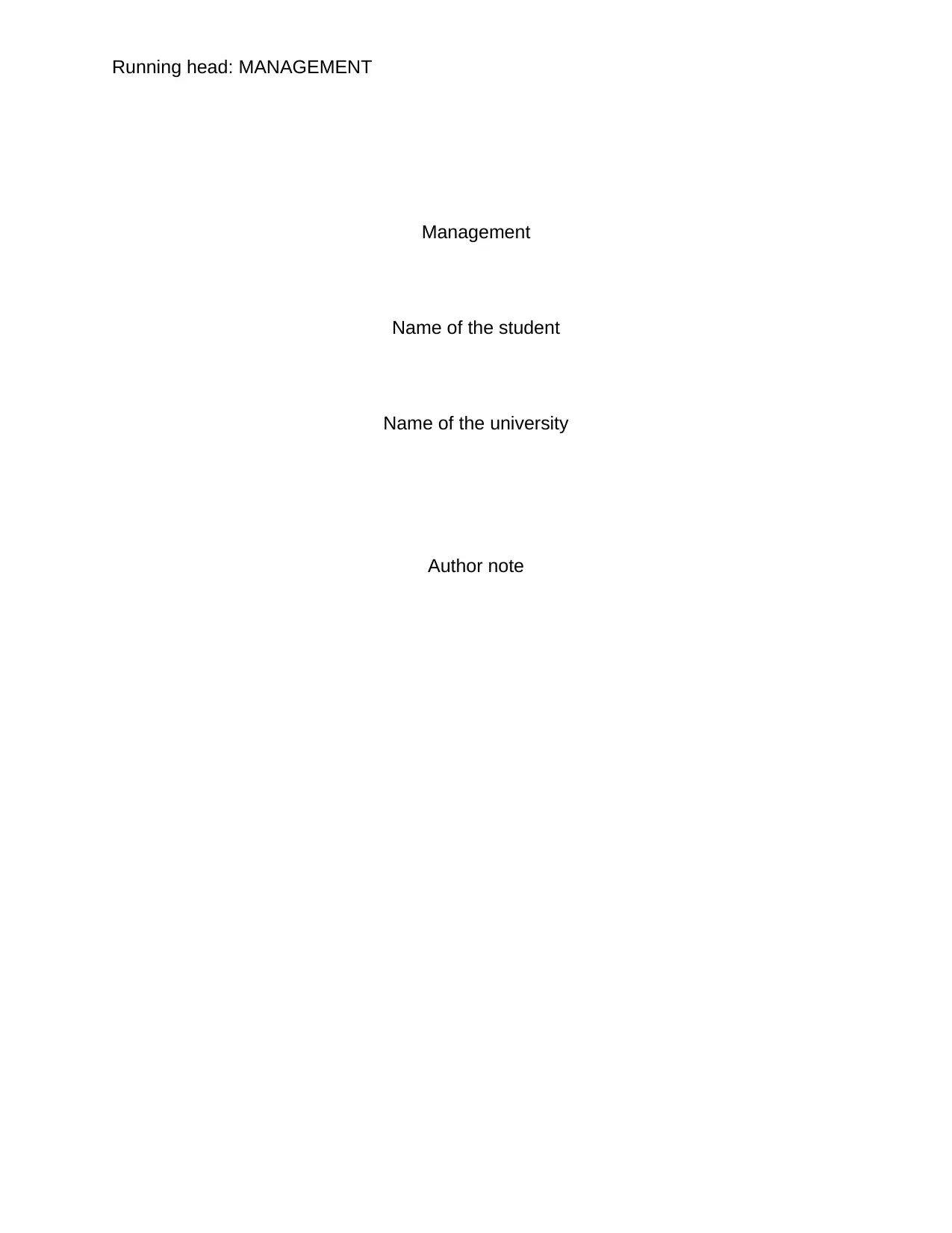
Running head: MANAGEMENT
Management
Name of the student
Name of the university
Author note
Management
Name of the student
Name of the university
Author note
Paraphrase This Document
Need a fresh take? Get an instant paraphrase of this document with our AI Paraphraser
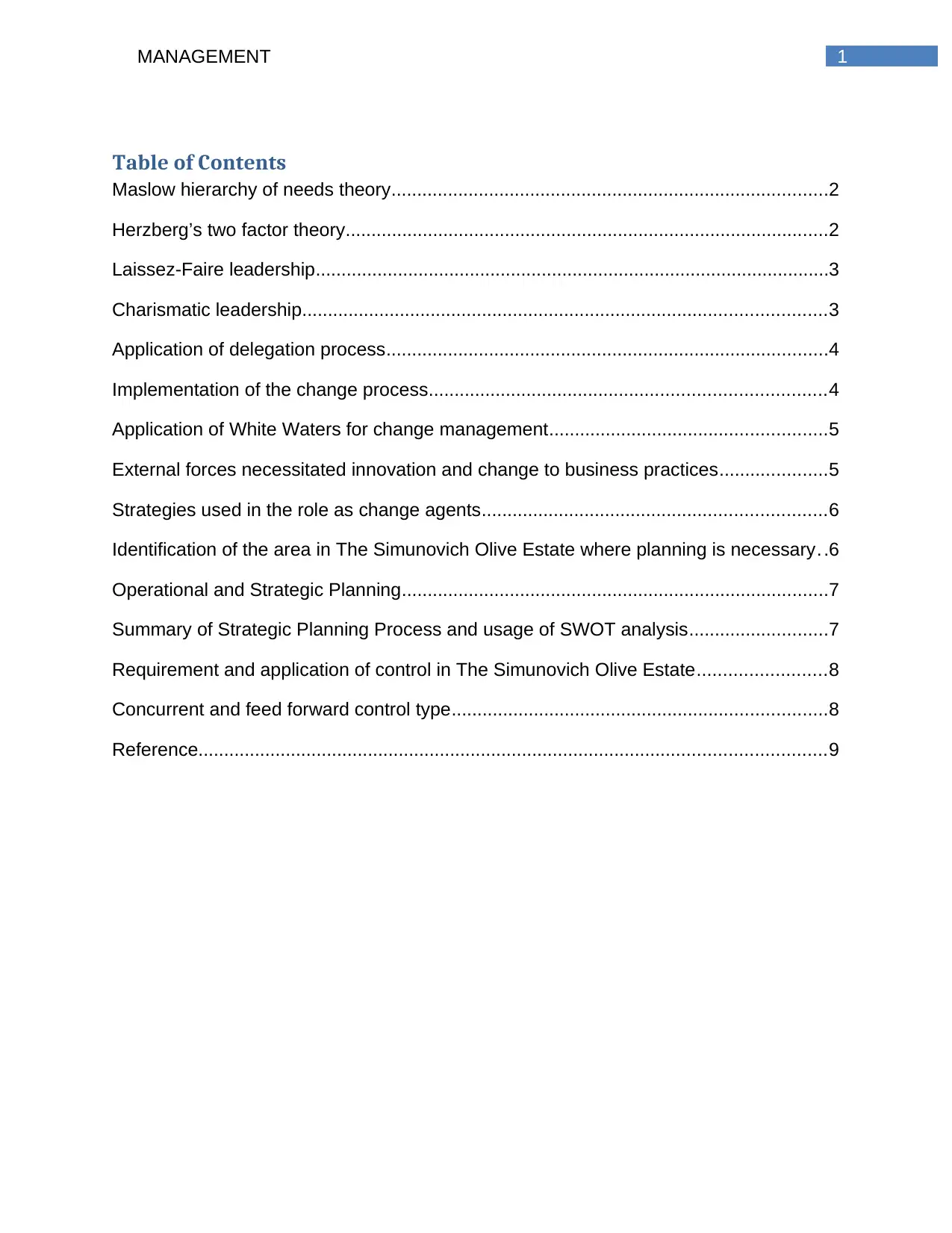
1MANAGEMENT
Table of Contents
Maslow hierarchy of needs theory.....................................................................................2
Herzberg’s two factor theory..............................................................................................2
Laissez-Faire leadership....................................................................................................3
Charismatic leadership......................................................................................................3
Application of delegation process......................................................................................4
Implementation of the change process.............................................................................4
Application of White Waters for change management......................................................5
External forces necessitated innovation and change to business practices.....................5
Strategies used in the role as change agents...................................................................6
Identification of the area in The Simunovich Olive Estate where planning is necessary. .6
Operational and Strategic Planning...................................................................................7
Summary of Strategic Planning Process and usage of SWOT analysis...........................7
Requirement and application of control in The Simunovich Olive Estate.........................8
Concurrent and feed forward control type.........................................................................8
Reference..........................................................................................................................9
Table of Contents
Maslow hierarchy of needs theory.....................................................................................2
Herzberg’s two factor theory..............................................................................................2
Laissez-Faire leadership....................................................................................................3
Charismatic leadership......................................................................................................3
Application of delegation process......................................................................................4
Implementation of the change process.............................................................................4
Application of White Waters for change management......................................................5
External forces necessitated innovation and change to business practices.....................5
Strategies used in the role as change agents...................................................................6
Identification of the area in The Simunovich Olive Estate where planning is necessary. .6
Operational and Strategic Planning...................................................................................7
Summary of Strategic Planning Process and usage of SWOT analysis...........................7
Requirement and application of control in The Simunovich Olive Estate.........................8
Concurrent and feed forward control type.........................................................................8
Reference..........................................................................................................................9
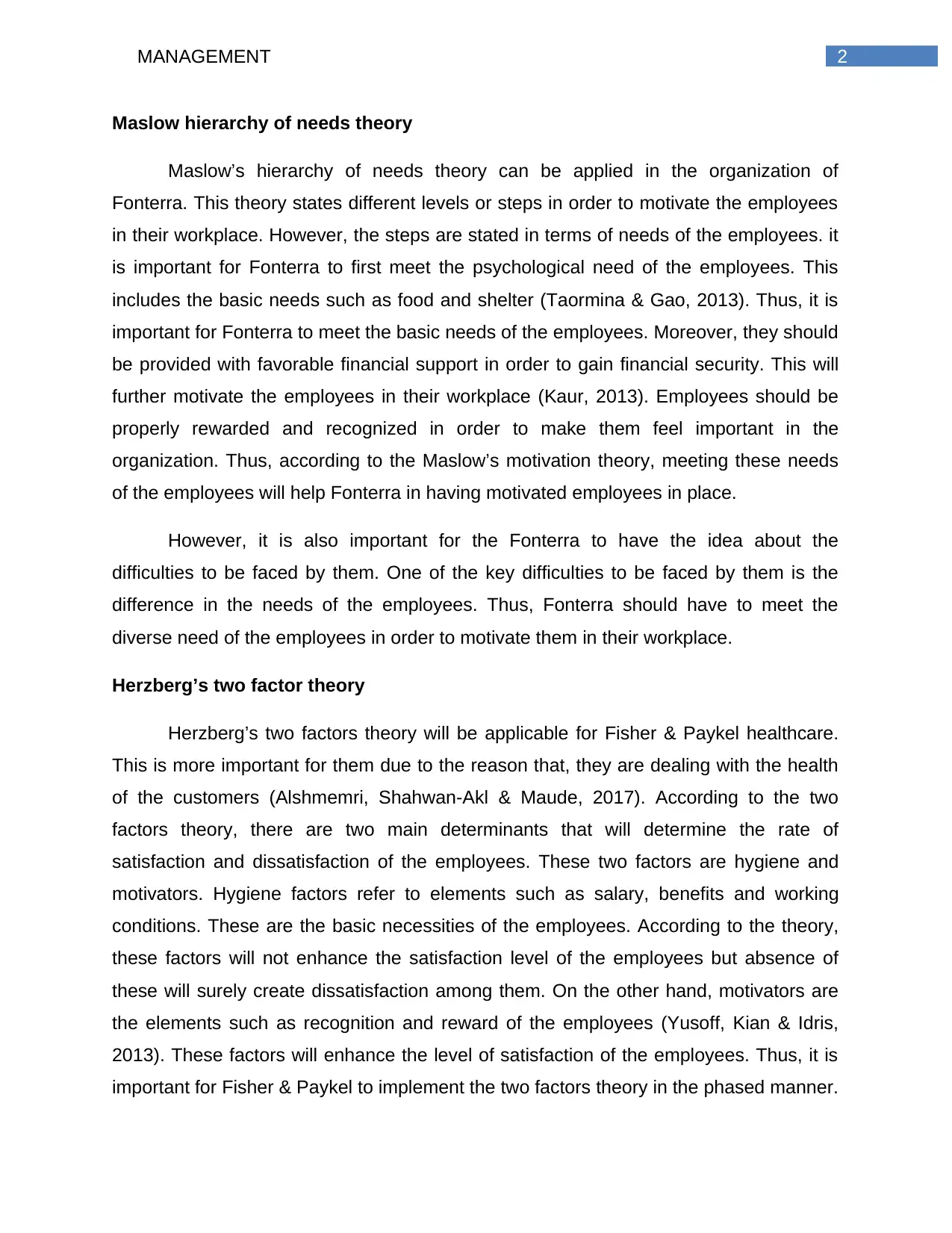
2MANAGEMENT
Maslow hierarchy of needs theory
Maslow’s hierarchy of needs theory can be applied in the organization of
Fonterra. This theory states different levels or steps in order to motivate the employees
in their workplace. However, the steps are stated in terms of needs of the employees. it
is important for Fonterra to first meet the psychological need of the employees. This
includes the basic needs such as food and shelter (Taormina & Gao, 2013). Thus, it is
important for Fonterra to meet the basic needs of the employees. Moreover, they should
be provided with favorable financial support in order to gain financial security. This will
further motivate the employees in their workplace (Kaur, 2013). Employees should be
properly rewarded and recognized in order to make them feel important in the
organization. Thus, according to the Maslow’s motivation theory, meeting these needs
of the employees will help Fonterra in having motivated employees in place.
However, it is also important for the Fonterra to have the idea about the
difficulties to be faced by them. One of the key difficulties to be faced by them is the
difference in the needs of the employees. Thus, Fonterra should have to meet the
diverse need of the employees in order to motivate them in their workplace.
Herzberg’s two factor theory
Herzberg’s two factors theory will be applicable for Fisher & Paykel healthcare.
This is more important for them due to the reason that, they are dealing with the health
of the customers (Alshmemri, Shahwan-Akl & Maude, 2017). According to the two
factors theory, there are two main determinants that will determine the rate of
satisfaction and dissatisfaction of the employees. These two factors are hygiene and
motivators. Hygiene factors refer to elements such as salary, benefits and working
conditions. These are the basic necessities of the employees. According to the theory,
these factors will not enhance the satisfaction level of the employees but absence of
these will surely create dissatisfaction among them. On the other hand, motivators are
the elements such as recognition and reward of the employees (Yusoff, Kian & Idris,
2013). These factors will enhance the level of satisfaction of the employees. Thus, it is
important for Fisher & Paykel to implement the two factors theory in the phased manner.
Maslow hierarchy of needs theory
Maslow’s hierarchy of needs theory can be applied in the organization of
Fonterra. This theory states different levels or steps in order to motivate the employees
in their workplace. However, the steps are stated in terms of needs of the employees. it
is important for Fonterra to first meet the psychological need of the employees. This
includes the basic needs such as food and shelter (Taormina & Gao, 2013). Thus, it is
important for Fonterra to meet the basic needs of the employees. Moreover, they should
be provided with favorable financial support in order to gain financial security. This will
further motivate the employees in their workplace (Kaur, 2013). Employees should be
properly rewarded and recognized in order to make them feel important in the
organization. Thus, according to the Maslow’s motivation theory, meeting these needs
of the employees will help Fonterra in having motivated employees in place.
However, it is also important for the Fonterra to have the idea about the
difficulties to be faced by them. One of the key difficulties to be faced by them is the
difference in the needs of the employees. Thus, Fonterra should have to meet the
diverse need of the employees in order to motivate them in their workplace.
Herzberg’s two factor theory
Herzberg’s two factors theory will be applicable for Fisher & Paykel healthcare.
This is more important for them due to the reason that, they are dealing with the health
of the customers (Alshmemri, Shahwan-Akl & Maude, 2017). According to the two
factors theory, there are two main determinants that will determine the rate of
satisfaction and dissatisfaction of the employees. These two factors are hygiene and
motivators. Hygiene factors refer to elements such as salary, benefits and working
conditions. These are the basic necessities of the employees. According to the theory,
these factors will not enhance the satisfaction level of the employees but absence of
these will surely create dissatisfaction among them. On the other hand, motivators are
the elements such as recognition and reward of the employees (Yusoff, Kian & Idris,
2013). These factors will enhance the level of satisfaction of the employees. Thus, it is
important for Fisher & Paykel to implement the two factors theory in the phased manner.
⊘ This is a preview!⊘
Do you want full access?
Subscribe today to unlock all pages.

Trusted by 1+ million students worldwide
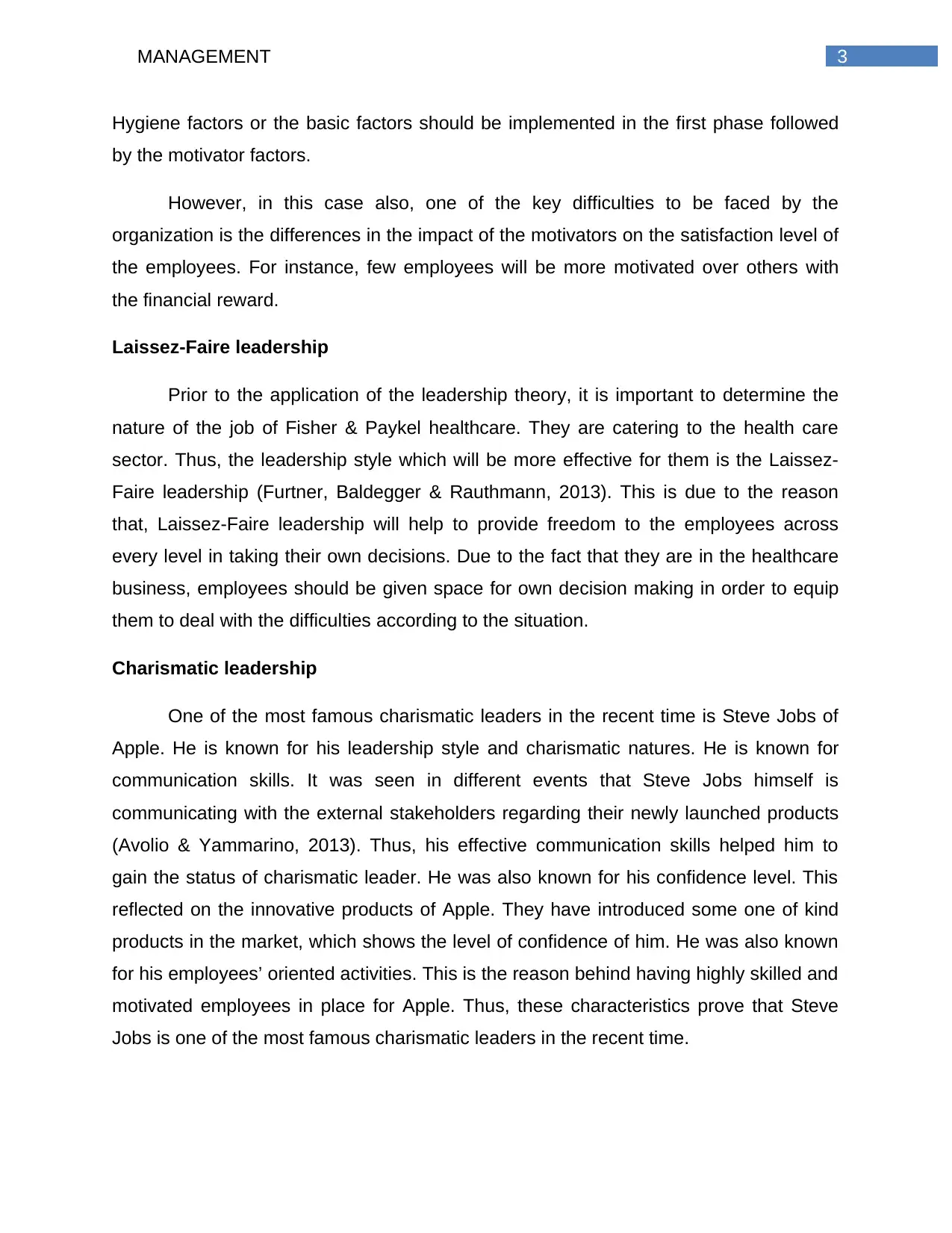
3MANAGEMENT
Hygiene factors or the basic factors should be implemented in the first phase followed
by the motivator factors.
However, in this case also, one of the key difficulties to be faced by the
organization is the differences in the impact of the motivators on the satisfaction level of
the employees. For instance, few employees will be more motivated over others with
the financial reward.
Laissez-Faire leadership
Prior to the application of the leadership theory, it is important to determine the
nature of the job of Fisher & Paykel healthcare. They are catering to the health care
sector. Thus, the leadership style which will be more effective for them is the Laissez-
Faire leadership (Furtner, Baldegger & Rauthmann, 2013). This is due to the reason
that, Laissez-Faire leadership will help to provide freedom to the employees across
every level in taking their own decisions. Due to the fact that they are in the healthcare
business, employees should be given space for own decision making in order to equip
them to deal with the difficulties according to the situation.
Charismatic leadership
One of the most famous charismatic leaders in the recent time is Steve Jobs of
Apple. He is known for his leadership style and charismatic natures. He is known for
communication skills. It was seen in different events that Steve Jobs himself is
communicating with the external stakeholders regarding their newly launched products
(Avolio & Yammarino, 2013). Thus, his effective communication skills helped him to
gain the status of charismatic leader. He was also known for his confidence level. This
reflected on the innovative products of Apple. They have introduced some one of kind
products in the market, which shows the level of confidence of him. He was also known
for his employees’ oriented activities. This is the reason behind having highly skilled and
motivated employees in place for Apple. Thus, these characteristics prove that Steve
Jobs is one of the most famous charismatic leaders in the recent time.
Hygiene factors or the basic factors should be implemented in the first phase followed
by the motivator factors.
However, in this case also, one of the key difficulties to be faced by the
organization is the differences in the impact of the motivators on the satisfaction level of
the employees. For instance, few employees will be more motivated over others with
the financial reward.
Laissez-Faire leadership
Prior to the application of the leadership theory, it is important to determine the
nature of the job of Fisher & Paykel healthcare. They are catering to the health care
sector. Thus, the leadership style which will be more effective for them is the Laissez-
Faire leadership (Furtner, Baldegger & Rauthmann, 2013). This is due to the reason
that, Laissez-Faire leadership will help to provide freedom to the employees across
every level in taking their own decisions. Due to the fact that they are in the healthcare
business, employees should be given space for own decision making in order to equip
them to deal with the difficulties according to the situation.
Charismatic leadership
One of the most famous charismatic leaders in the recent time is Steve Jobs of
Apple. He is known for his leadership style and charismatic natures. He is known for
communication skills. It was seen in different events that Steve Jobs himself is
communicating with the external stakeholders regarding their newly launched products
(Avolio & Yammarino, 2013). Thus, his effective communication skills helped him to
gain the status of charismatic leader. He was also known for his confidence level. This
reflected on the innovative products of Apple. They have introduced some one of kind
products in the market, which shows the level of confidence of him. He was also known
for his employees’ oriented activities. This is the reason behind having highly skilled and
motivated employees in place for Apple. Thus, these characteristics prove that Steve
Jobs is one of the most famous charismatic leaders in the recent time.
Paraphrase This Document
Need a fresh take? Get an instant paraphrase of this document with our AI Paraphraser
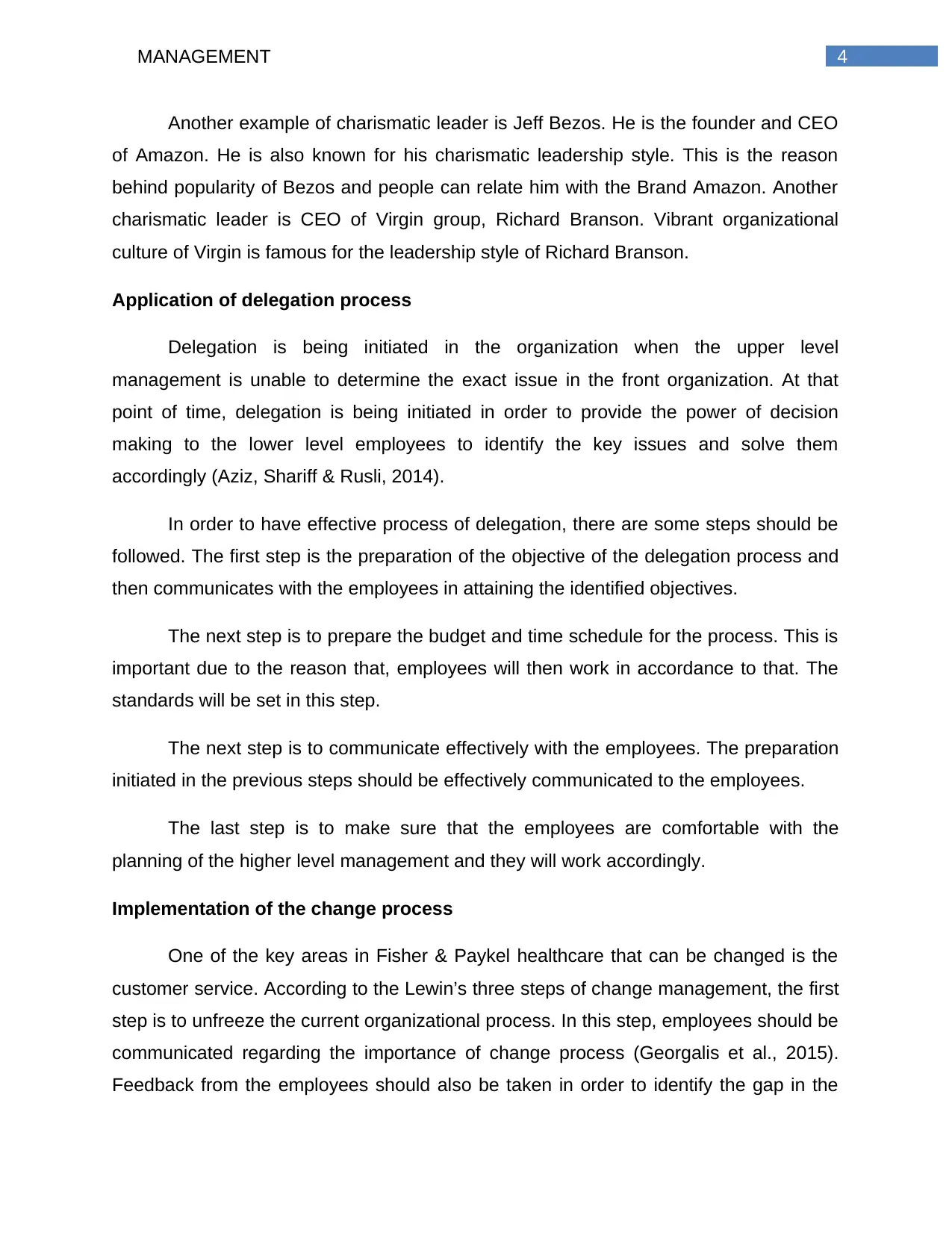
4MANAGEMENT
Another example of charismatic leader is Jeff Bezos. He is the founder and CEO
of Amazon. He is also known for his charismatic leadership style. This is the reason
behind popularity of Bezos and people can relate him with the Brand Amazon. Another
charismatic leader is CEO of Virgin group, Richard Branson. Vibrant organizational
culture of Virgin is famous for the leadership style of Richard Branson.
Application of delegation process
Delegation is being initiated in the organization when the upper level
management is unable to determine the exact issue in the front organization. At that
point of time, delegation is being initiated in order to provide the power of decision
making to the lower level employees to identify the key issues and solve them
accordingly (Aziz, Shariff & Rusli, 2014).
In order to have effective process of delegation, there are some steps should be
followed. The first step is the preparation of the objective of the delegation process and
then communicates with the employees in attaining the identified objectives.
The next step is to prepare the budget and time schedule for the process. This is
important due to the reason that, employees will then work in accordance to that. The
standards will be set in this step.
The next step is to communicate effectively with the employees. The preparation
initiated in the previous steps should be effectively communicated to the employees.
The last step is to make sure that the employees are comfortable with the
planning of the higher level management and they will work accordingly.
Implementation of the change process
One of the key areas in Fisher & Paykel healthcare that can be changed is the
customer service. According to the Lewin’s three steps of change management, the first
step is to unfreeze the current organizational process. In this step, employees should be
communicated regarding the importance of change process (Georgalis et al., 2015).
Feedback from the employees should also be taken in order to identify the gap in the
Another example of charismatic leader is Jeff Bezos. He is the founder and CEO
of Amazon. He is also known for his charismatic leadership style. This is the reason
behind popularity of Bezos and people can relate him with the Brand Amazon. Another
charismatic leader is CEO of Virgin group, Richard Branson. Vibrant organizational
culture of Virgin is famous for the leadership style of Richard Branson.
Application of delegation process
Delegation is being initiated in the organization when the upper level
management is unable to determine the exact issue in the front organization. At that
point of time, delegation is being initiated in order to provide the power of decision
making to the lower level employees to identify the key issues and solve them
accordingly (Aziz, Shariff & Rusli, 2014).
In order to have effective process of delegation, there are some steps should be
followed. The first step is the preparation of the objective of the delegation process and
then communicates with the employees in attaining the identified objectives.
The next step is to prepare the budget and time schedule for the process. This is
important due to the reason that, employees will then work in accordance to that. The
standards will be set in this step.
The next step is to communicate effectively with the employees. The preparation
initiated in the previous steps should be effectively communicated to the employees.
The last step is to make sure that the employees are comfortable with the
planning of the higher level management and they will work accordingly.
Implementation of the change process
One of the key areas in Fisher & Paykel healthcare that can be changed is the
customer service. According to the Lewin’s three steps of change management, the first
step is to unfreeze the current organizational process. In this step, employees should be
communicated regarding the importance of change process (Georgalis et al., 2015).
Feedback from the employees should also be taken in order to identify the gap in the
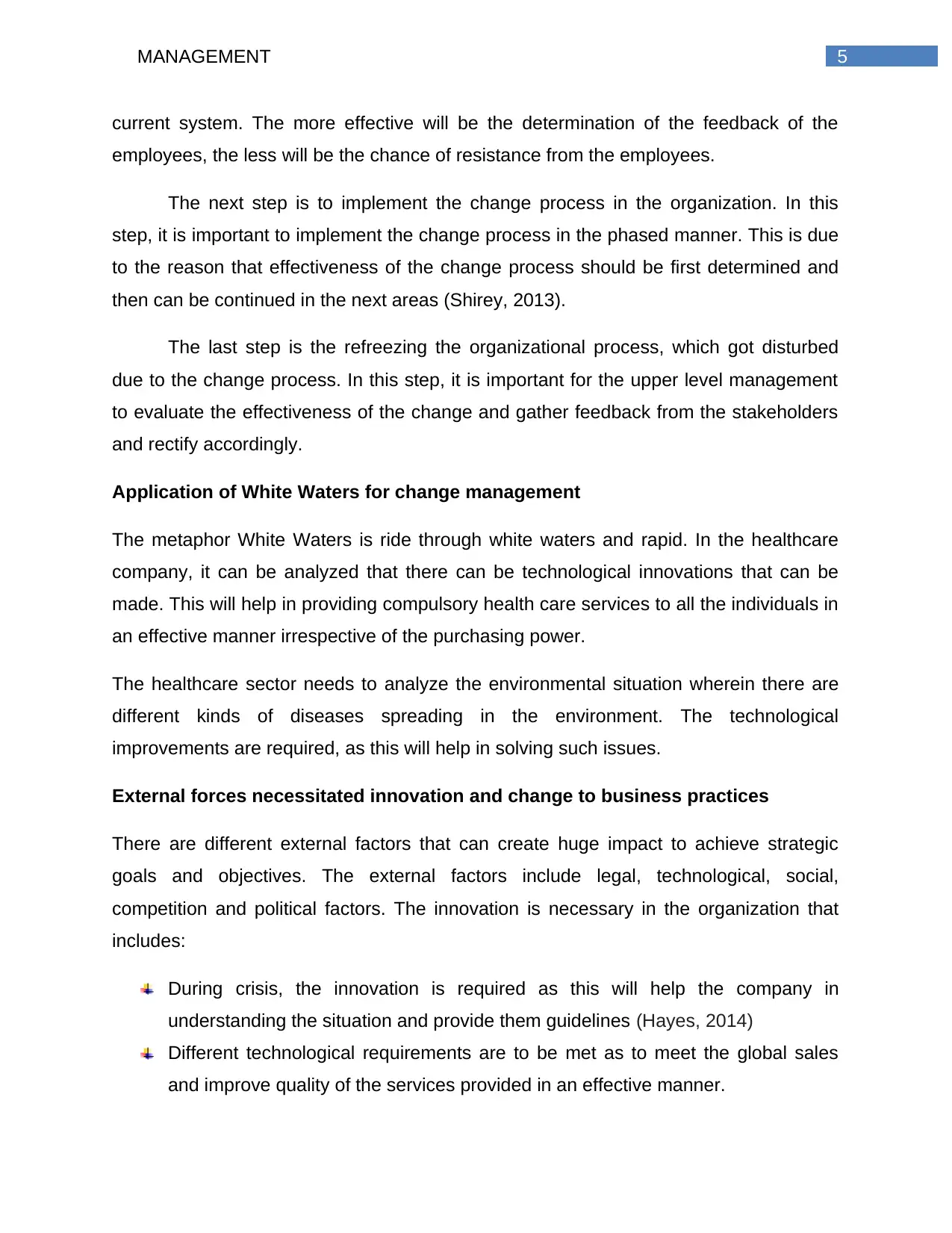
5MANAGEMENT
current system. The more effective will be the determination of the feedback of the
employees, the less will be the chance of resistance from the employees.
The next step is to implement the change process in the organization. In this
step, it is important to implement the change process in the phased manner. This is due
to the reason that effectiveness of the change process should be first determined and
then can be continued in the next areas (Shirey, 2013).
The last step is the refreezing the organizational process, which got disturbed
due to the change process. In this step, it is important for the upper level management
to evaluate the effectiveness of the change and gather feedback from the stakeholders
and rectify accordingly.
Application of White Waters for change management
The metaphor White Waters is ride through white waters and rapid. In the healthcare
company, it can be analyzed that there can be technological innovations that can be
made. This will help in providing compulsory health care services to all the individuals in
an effective manner irrespective of the purchasing power.
The healthcare sector needs to analyze the environmental situation wherein there are
different kinds of diseases spreading in the environment. The technological
improvements are required, as this will help in solving such issues.
External forces necessitated innovation and change to business practices
There are different external factors that can create huge impact to achieve strategic
goals and objectives. The external factors include legal, technological, social,
competition and political factors. The innovation is necessary in the organization that
includes:
During crisis, the innovation is required as this will help the company in
understanding the situation and provide them guidelines (Hayes, 2014)
Different technological requirements are to be met as to meet the global sales
and improve quality of the services provided in an effective manner.
current system. The more effective will be the determination of the feedback of the
employees, the less will be the chance of resistance from the employees.
The next step is to implement the change process in the organization. In this
step, it is important to implement the change process in the phased manner. This is due
to the reason that effectiveness of the change process should be first determined and
then can be continued in the next areas (Shirey, 2013).
The last step is the refreezing the organizational process, which got disturbed
due to the change process. In this step, it is important for the upper level management
to evaluate the effectiveness of the change and gather feedback from the stakeholders
and rectify accordingly.
Application of White Waters for change management
The metaphor White Waters is ride through white waters and rapid. In the healthcare
company, it can be analyzed that there can be technological innovations that can be
made. This will help in providing compulsory health care services to all the individuals in
an effective manner irrespective of the purchasing power.
The healthcare sector needs to analyze the environmental situation wherein there are
different kinds of diseases spreading in the environment. The technological
improvements are required, as this will help in solving such issues.
External forces necessitated innovation and change to business practices
There are different external factors that can create huge impact to achieve strategic
goals and objectives. The external factors include legal, technological, social,
competition and political factors. The innovation is necessary in the organization that
includes:
During crisis, the innovation is required as this will help the company in
understanding the situation and provide them guidelines (Hayes, 2014)
Different technological requirements are to be met as to meet the global sales
and improve quality of the services provided in an effective manner.
⊘ This is a preview!⊘
Do you want full access?
Subscribe today to unlock all pages.

Trusted by 1+ million students worldwide
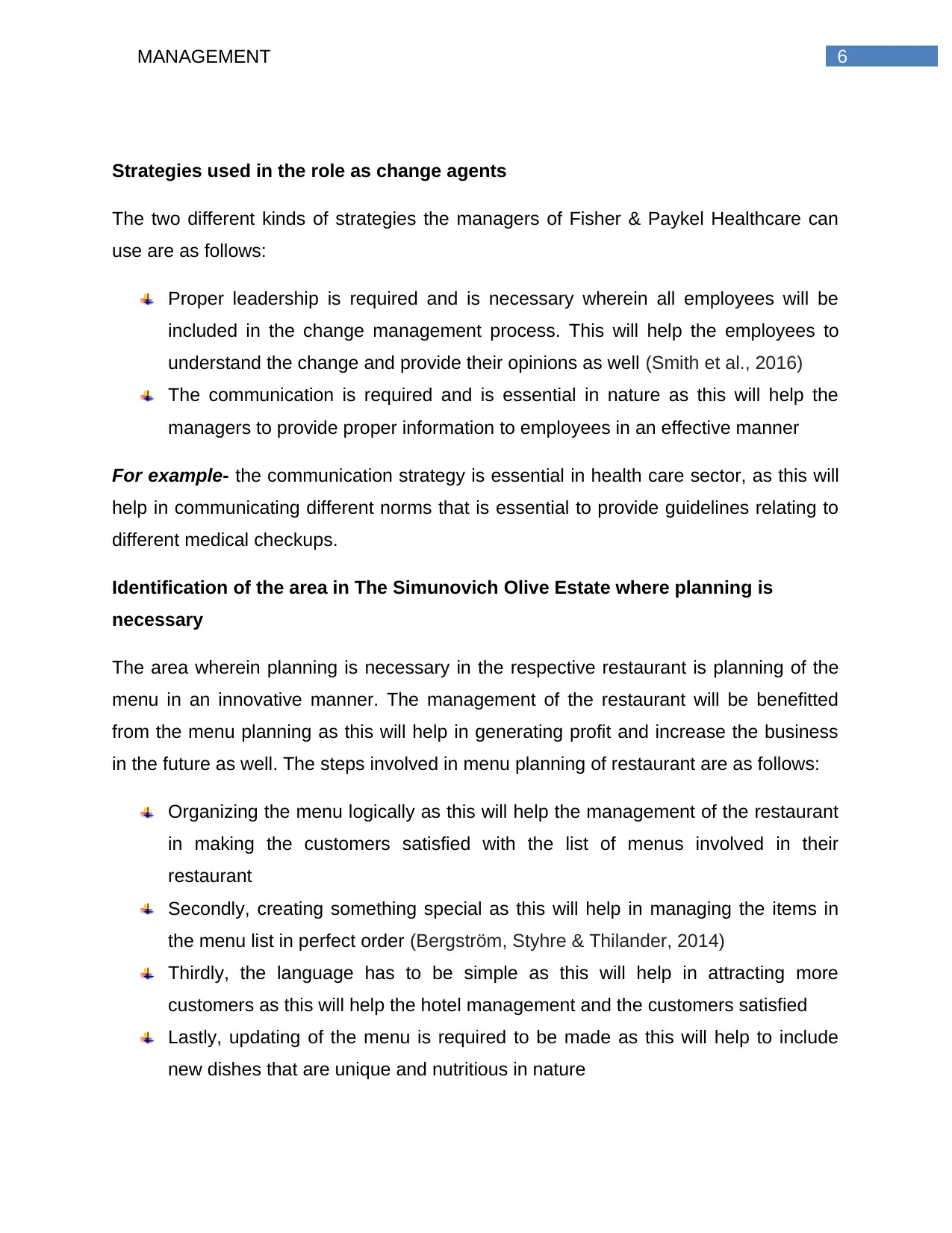
6MANAGEMENT
Strategies used in the role as change agents
The two different kinds of strategies the managers of Fisher & Paykel Healthcare can
use are as follows:
Proper leadership is required and is necessary wherein all employees will be
included in the change management process. This will help the employees to
understand the change and provide their opinions as well (Smith et al., 2016)
The communication is required and is essential in nature as this will help the
managers to provide proper information to employees in an effective manner
For example- the communication strategy is essential in health care sector, as this will
help in communicating different norms that is essential to provide guidelines relating to
different medical checkups.
Identification of the area in The Simunovich Olive Estate where planning is
necessary
The area wherein planning is necessary in the respective restaurant is planning of the
menu in an innovative manner. The management of the restaurant will be benefitted
from the menu planning as this will help in generating profit and increase the business
in the future as well. The steps involved in menu planning of restaurant are as follows:
Organizing the menu logically as this will help the management of the restaurant
in making the customers satisfied with the list of menus involved in their
restaurant
Secondly, creating something special as this will help in managing the items in
the menu list in perfect order (Bergström, Styhre & Thilander, 2014)
Thirdly, the language has to be simple as this will help in attracting more
customers as this will help the hotel management and the customers satisfied
Lastly, updating of the menu is required to be made as this will help to include
new dishes that are unique and nutritious in nature
Strategies used in the role as change agents
The two different kinds of strategies the managers of Fisher & Paykel Healthcare can
use are as follows:
Proper leadership is required and is necessary wherein all employees will be
included in the change management process. This will help the employees to
understand the change and provide their opinions as well (Smith et al., 2016)
The communication is required and is essential in nature as this will help the
managers to provide proper information to employees in an effective manner
For example- the communication strategy is essential in health care sector, as this will
help in communicating different norms that is essential to provide guidelines relating to
different medical checkups.
Identification of the area in The Simunovich Olive Estate where planning is
necessary
The area wherein planning is necessary in the respective restaurant is planning of the
menu in an innovative manner. The management of the restaurant will be benefitted
from the menu planning as this will help in generating profit and increase the business
in the future as well. The steps involved in menu planning of restaurant are as follows:
Organizing the menu logically as this will help the management of the restaurant
in making the customers satisfied with the list of menus involved in their
restaurant
Secondly, creating something special as this will help in managing the items in
the menu list in perfect order (Bergström, Styhre & Thilander, 2014)
Thirdly, the language has to be simple as this will help in attracting more
customers as this will help the hotel management and the customers satisfied
Lastly, updating of the menu is required to be made as this will help to include
new dishes that are unique and nutritious in nature
Paraphrase This Document
Need a fresh take? Get an instant paraphrase of this document with our AI Paraphraser
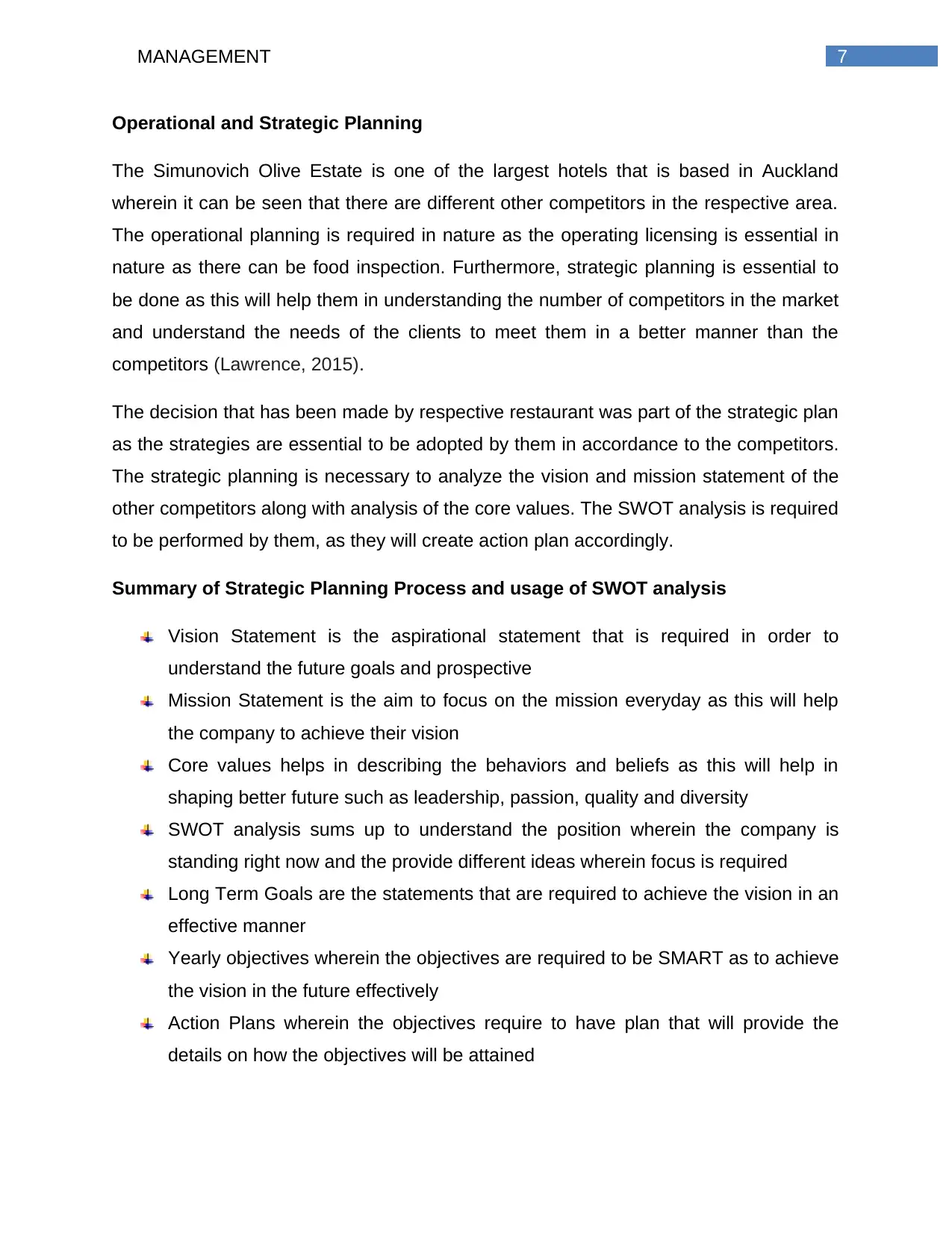
7MANAGEMENT
Operational and Strategic Planning
The Simunovich Olive Estate is one of the largest hotels that is based in Auckland
wherein it can be seen that there are different other competitors in the respective area.
The operational planning is required in nature as the operating licensing is essential in
nature as there can be food inspection. Furthermore, strategic planning is essential to
be done as this will help them in understanding the number of competitors in the market
and understand the needs of the clients to meet them in a better manner than the
competitors (Lawrence, 2015).
The decision that has been made by respective restaurant was part of the strategic plan
as the strategies are essential to be adopted by them in accordance to the competitors.
The strategic planning is necessary to analyze the vision and mission statement of the
other competitors along with analysis of the core values. The SWOT analysis is required
to be performed by them, as they will create action plan accordingly.
Summary of Strategic Planning Process and usage of SWOT analysis
Vision Statement is the aspirational statement that is required in order to
understand the future goals and prospective
Mission Statement is the aim to focus on the mission everyday as this will help
the company to achieve their vision
Core values helps in describing the behaviors and beliefs as this will help in
shaping better future such as leadership, passion, quality and diversity
SWOT analysis sums up to understand the position wherein the company is
standing right now and the provide different ideas wherein focus is required
Long Term Goals are the statements that are required to achieve the vision in an
effective manner
Yearly objectives wherein the objectives are required to be SMART as to achieve
the vision in the future effectively
Action Plans wherein the objectives require to have plan that will provide the
details on how the objectives will be attained
Operational and Strategic Planning
The Simunovich Olive Estate is one of the largest hotels that is based in Auckland
wherein it can be seen that there are different other competitors in the respective area.
The operational planning is required in nature as the operating licensing is essential in
nature as there can be food inspection. Furthermore, strategic planning is essential to
be done as this will help them in understanding the number of competitors in the market
and understand the needs of the clients to meet them in a better manner than the
competitors (Lawrence, 2015).
The decision that has been made by respective restaurant was part of the strategic plan
as the strategies are essential to be adopted by them in accordance to the competitors.
The strategic planning is necessary to analyze the vision and mission statement of the
other competitors along with analysis of the core values. The SWOT analysis is required
to be performed by them, as they will create action plan accordingly.
Summary of Strategic Planning Process and usage of SWOT analysis
Vision Statement is the aspirational statement that is required in order to
understand the future goals and prospective
Mission Statement is the aim to focus on the mission everyday as this will help
the company to achieve their vision
Core values helps in describing the behaviors and beliefs as this will help in
shaping better future such as leadership, passion, quality and diversity
SWOT analysis sums up to understand the position wherein the company is
standing right now and the provide different ideas wherein focus is required
Long Term Goals are the statements that are required to achieve the vision in an
effective manner
Yearly objectives wherein the objectives are required to be SMART as to achieve
the vision in the future effectively
Action Plans wherein the objectives require to have plan that will provide the
details on how the objectives will be attained
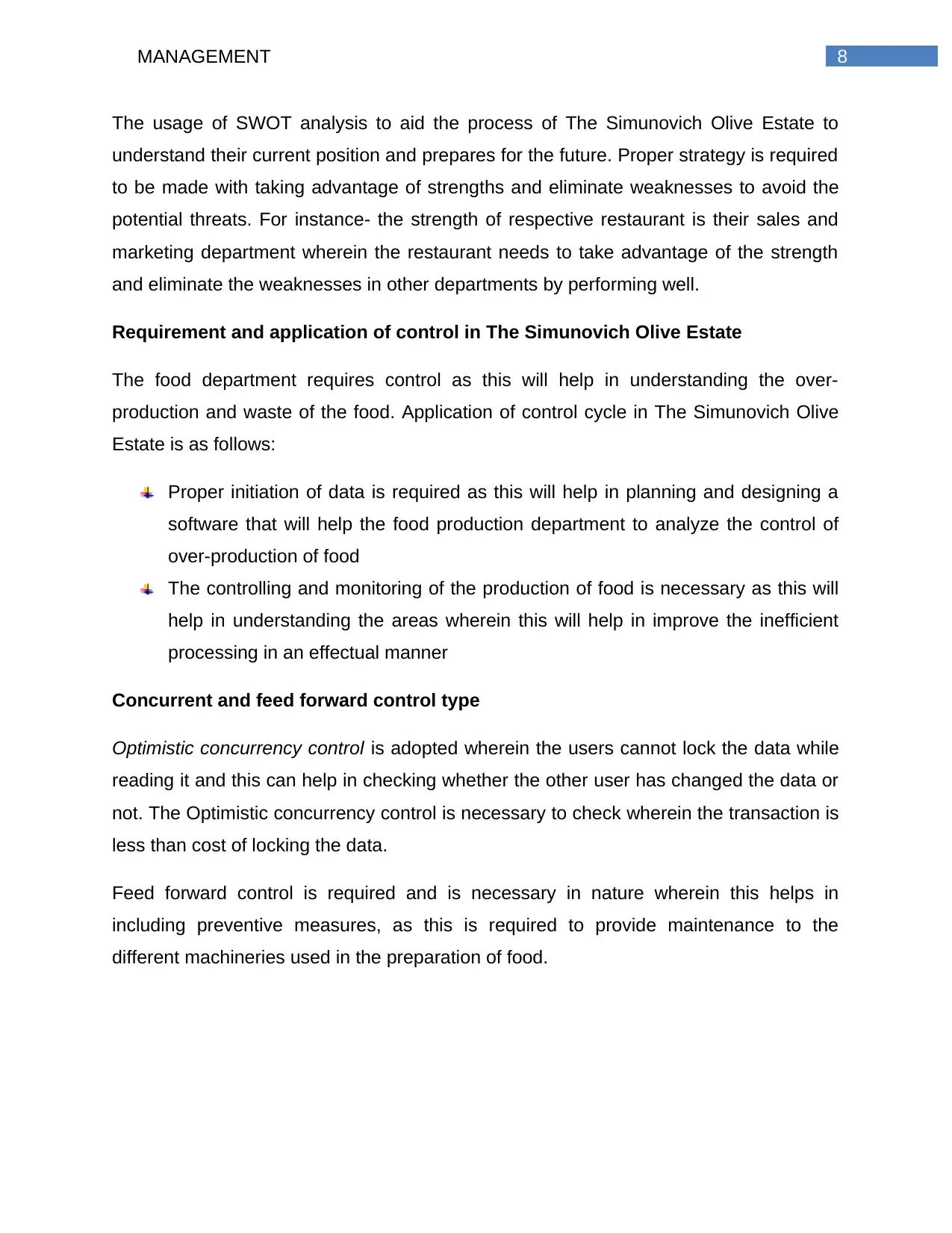
8MANAGEMENT
The usage of SWOT analysis to aid the process of The Simunovich Olive Estate to
understand their current position and prepares for the future. Proper strategy is required
to be made with taking advantage of strengths and eliminate weaknesses to avoid the
potential threats. For instance- the strength of respective restaurant is their sales and
marketing department wherein the restaurant needs to take advantage of the strength
and eliminate the weaknesses in other departments by performing well.
Requirement and application of control in The Simunovich Olive Estate
The food department requires control as this will help in understanding the over-
production and waste of the food. Application of control cycle in The Simunovich Olive
Estate is as follows:
Proper initiation of data is required as this will help in planning and designing a
software that will help the food production department to analyze the control of
over-production of food
The controlling and monitoring of the production of food is necessary as this will
help in understanding the areas wherein this will help in improve the inefficient
processing in an effectual manner
Concurrent and feed forward control type
Optimistic concurrency control is adopted wherein the users cannot lock the data while
reading it and this can help in checking whether the other user has changed the data or
not. The Optimistic concurrency control is necessary to check wherein the transaction is
less than cost of locking the data.
Feed forward control is required and is necessary in nature wherein this helps in
including preventive measures, as this is required to provide maintenance to the
different machineries used in the preparation of food.
The usage of SWOT analysis to aid the process of The Simunovich Olive Estate to
understand their current position and prepares for the future. Proper strategy is required
to be made with taking advantage of strengths and eliminate weaknesses to avoid the
potential threats. For instance- the strength of respective restaurant is their sales and
marketing department wherein the restaurant needs to take advantage of the strength
and eliminate the weaknesses in other departments by performing well.
Requirement and application of control in The Simunovich Olive Estate
The food department requires control as this will help in understanding the over-
production and waste of the food. Application of control cycle in The Simunovich Olive
Estate is as follows:
Proper initiation of data is required as this will help in planning and designing a
software that will help the food production department to analyze the control of
over-production of food
The controlling and monitoring of the production of food is necessary as this will
help in understanding the areas wherein this will help in improve the inefficient
processing in an effectual manner
Concurrent and feed forward control type
Optimistic concurrency control is adopted wherein the users cannot lock the data while
reading it and this can help in checking whether the other user has changed the data or
not. The Optimistic concurrency control is necessary to check wherein the transaction is
less than cost of locking the data.
Feed forward control is required and is necessary in nature wherein this helps in
including preventive measures, as this is required to provide maintenance to the
different machineries used in the preparation of food.
⊘ This is a preview!⊘
Do you want full access?
Subscribe today to unlock all pages.

Trusted by 1+ million students worldwide
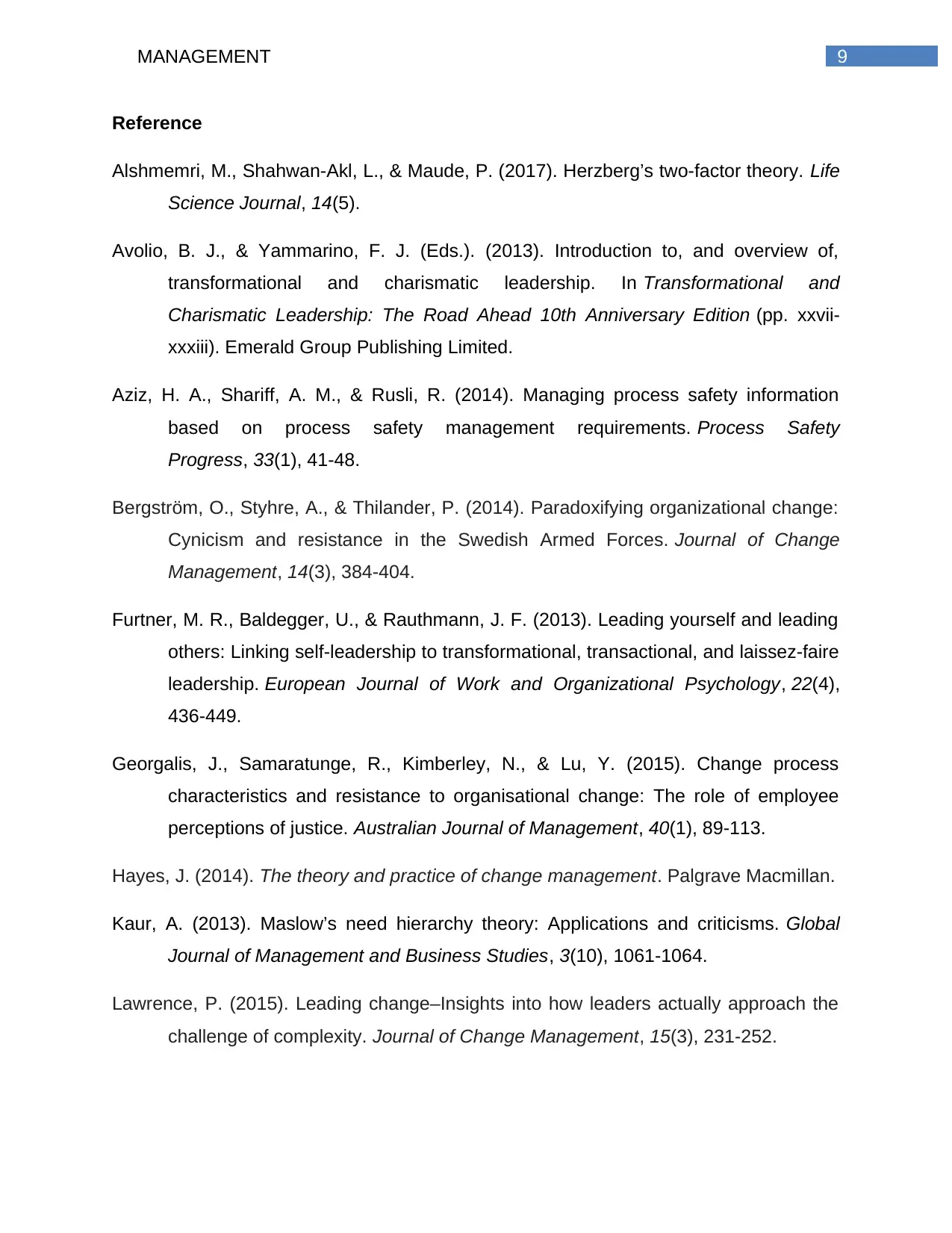
9MANAGEMENT
Reference
Alshmemri, M., Shahwan-Akl, L., & Maude, P. (2017). Herzberg’s two-factor theory. Life
Science Journal, 14(5).
Avolio, B. J., & Yammarino, F. J. (Eds.). (2013). Introduction to, and overview of,
transformational and charismatic leadership. In Transformational and
Charismatic Leadership: The Road Ahead 10th Anniversary Edition (pp. xxvii-
xxxiii). Emerald Group Publishing Limited.
Aziz, H. A., Shariff, A. M., & Rusli, R. (2014). Managing process safety information
based on process safety management requirements. Process Safety
Progress, 33(1), 41-48.
Bergström, O., Styhre, A., & Thilander, P. (2014). Paradoxifying organizational change:
Cynicism and resistance in the Swedish Armed Forces. Journal of Change
Management, 14(3), 384-404.
Furtner, M. R., Baldegger, U., & Rauthmann, J. F. (2013). Leading yourself and leading
others: Linking self-leadership to transformational, transactional, and laissez-faire
leadership. European Journal of Work and Organizational Psychology, 22(4),
436-449.
Georgalis, J., Samaratunge, R., Kimberley, N., & Lu, Y. (2015). Change process
characteristics and resistance to organisational change: The role of employee
perceptions of justice. Australian Journal of Management, 40(1), 89-113.
Hayes, J. (2014). The theory and practice of change management. Palgrave Macmillan.
Kaur, A. (2013). Maslow’s need hierarchy theory: Applications and criticisms. Global
Journal of Management and Business Studies, 3(10), 1061-1064.
Lawrence, P. (2015). Leading change–Insights into how leaders actually approach the
challenge of complexity. Journal of Change Management, 15(3), 231-252.
Reference
Alshmemri, M., Shahwan-Akl, L., & Maude, P. (2017). Herzberg’s two-factor theory. Life
Science Journal, 14(5).
Avolio, B. J., & Yammarino, F. J. (Eds.). (2013). Introduction to, and overview of,
transformational and charismatic leadership. In Transformational and
Charismatic Leadership: The Road Ahead 10th Anniversary Edition (pp. xxvii-
xxxiii). Emerald Group Publishing Limited.
Aziz, H. A., Shariff, A. M., & Rusli, R. (2014). Managing process safety information
based on process safety management requirements. Process Safety
Progress, 33(1), 41-48.
Bergström, O., Styhre, A., & Thilander, P. (2014). Paradoxifying organizational change:
Cynicism and resistance in the Swedish Armed Forces. Journal of Change
Management, 14(3), 384-404.
Furtner, M. R., Baldegger, U., & Rauthmann, J. F. (2013). Leading yourself and leading
others: Linking self-leadership to transformational, transactional, and laissez-faire
leadership. European Journal of Work and Organizational Psychology, 22(4),
436-449.
Georgalis, J., Samaratunge, R., Kimberley, N., & Lu, Y. (2015). Change process
characteristics and resistance to organisational change: The role of employee
perceptions of justice. Australian Journal of Management, 40(1), 89-113.
Hayes, J. (2014). The theory and practice of change management. Palgrave Macmillan.
Kaur, A. (2013). Maslow’s need hierarchy theory: Applications and criticisms. Global
Journal of Management and Business Studies, 3(10), 1061-1064.
Lawrence, P. (2015). Leading change–Insights into how leaders actually approach the
challenge of complexity. Journal of Change Management, 15(3), 231-252.
Paraphrase This Document
Need a fresh take? Get an instant paraphrase of this document with our AI Paraphraser
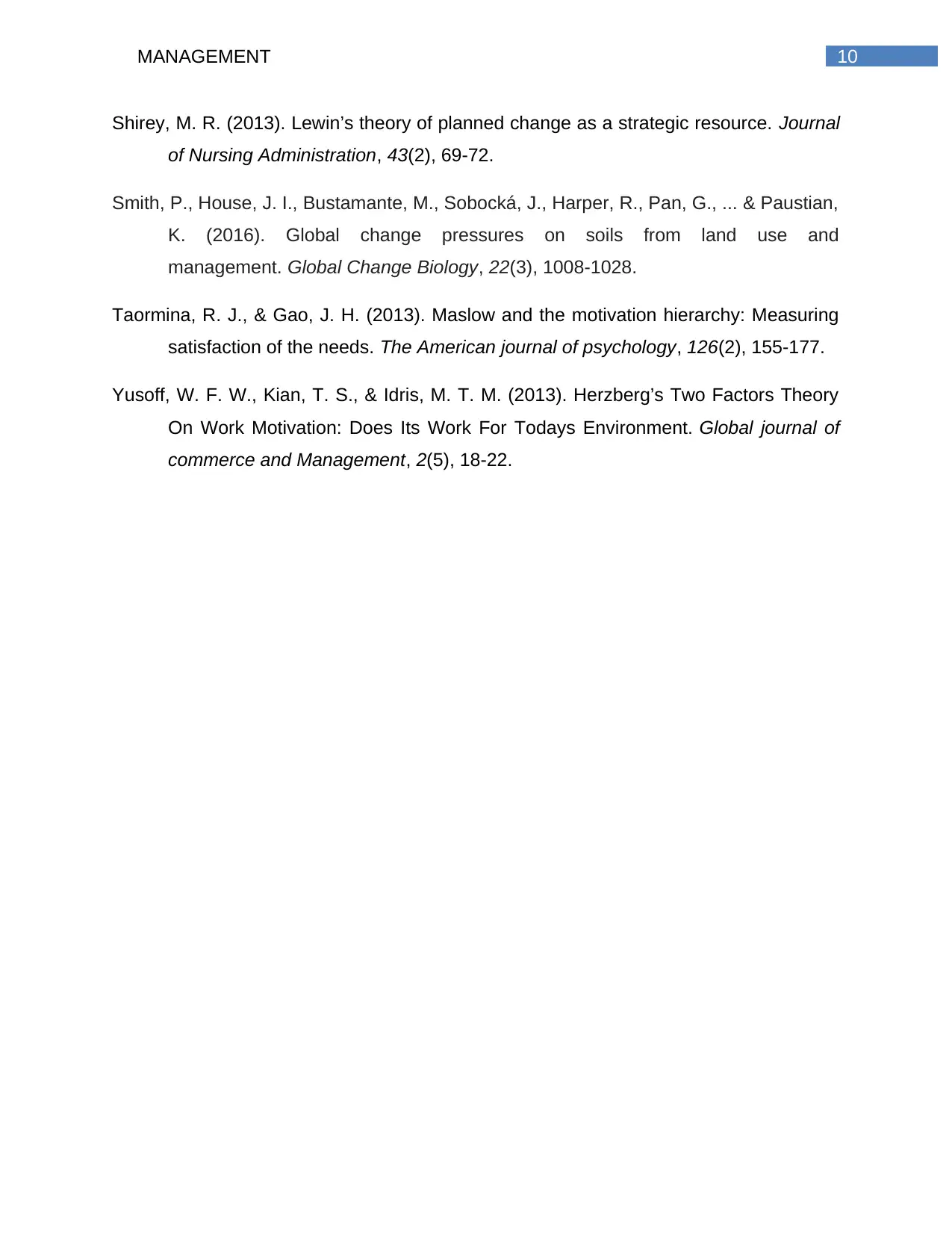
10MANAGEMENT
Shirey, M. R. (2013). Lewin’s theory of planned change as a strategic resource. Journal
of Nursing Administration, 43(2), 69-72.
Smith, P., House, J. I., Bustamante, M., Sobocká, J., Harper, R., Pan, G., ... & Paustian,
K. (2016). Global change pressures on soils from land use and
management. Global Change Biology, 22(3), 1008-1028.
Taormina, R. J., & Gao, J. H. (2013). Maslow and the motivation hierarchy: Measuring
satisfaction of the needs. The American journal of psychology, 126(2), 155-177.
Yusoff, W. F. W., Kian, T. S., & Idris, M. T. M. (2013). Herzberg’s Two Factors Theory
On Work Motivation: Does Its Work For Todays Environment. Global journal of
commerce and Management, 2(5), 18-22.
Shirey, M. R. (2013). Lewin’s theory of planned change as a strategic resource. Journal
of Nursing Administration, 43(2), 69-72.
Smith, P., House, J. I., Bustamante, M., Sobocká, J., Harper, R., Pan, G., ... & Paustian,
K. (2016). Global change pressures on soils from land use and
management. Global Change Biology, 22(3), 1008-1028.
Taormina, R. J., & Gao, J. H. (2013). Maslow and the motivation hierarchy: Measuring
satisfaction of the needs. The American journal of psychology, 126(2), 155-177.
Yusoff, W. F. W., Kian, T. S., & Idris, M. T. M. (2013). Herzberg’s Two Factors Theory
On Work Motivation: Does Its Work For Todays Environment. Global journal of
commerce and Management, 2(5), 18-22.
1 out of 11
Related Documents
Your All-in-One AI-Powered Toolkit for Academic Success.
+13062052269
info@desklib.com
Available 24*7 on WhatsApp / Email
![[object Object]](/_next/static/media/star-bottom.7253800d.svg)
Unlock your academic potential
Copyright © 2020–2025 A2Z Services. All Rights Reserved. Developed and managed by ZUCOL.





